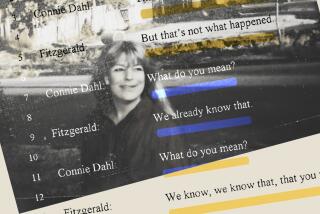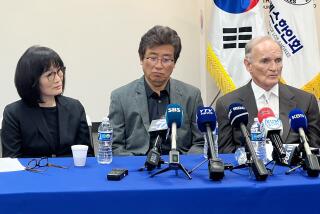Gruesome Video Opens Trial of Accused Mass Murderer Ng
- Share via
SANTA ANA — In a chilling presage of gruesome evidence, the long-delayed trial of accused mass murderer Charles Ng got underway Monday with excerpts from home videos showing Ng and a partner allegedly threatening to kill two women unless they became the men’s sex slaves.
The videos were found in a remote Calaveras County cabin where Ng is accused of taking a dozen kidnapped victims, including two infants, and then killing and dismembering them 14 years ago.
When investigators first went to the cabin, they found “a killing field, a mass graveyard,” Deputy State Atty. Gen. Sharlene Honnaka said in her opening statement to an Orange County jury of 14 women and four men, which includes six alternates.
Defense lawyer William Kelley, an Orange County deputy public defender, sought to focus attention on Ng’s partner, Leonard Lake. Kelley described Lake as a mentally disturbed man with a “deep-seated hatred for women.”
The case, one of the longest and costliest in state history--the tab is nearly $10 million so far--was transferred to Orange County because of pretrial publicity in Northern California. The trial is expected to last up to a year.
Ng may face the death penalty if convicted.
Most of the victims came from the San Francisco area, but they also included a Calaveras County family living nearby and a Garden Grove resident, Scott Stapley. Ng, who had fled to Canada, fought extradition and, once returned, delayed trial for years by filing myriad motions. He acted as his own attorney briefly and has had at least nine court-appointed defense attorneys.
In the packed courtroom, family members of Ng’s alleged victims wept as the prosecutor and the defense attorney outlined their cases.
Authorities accuse Ng and Lake of targeting their victims in 1984 and 1985 to steal their belongings, assume their identities and, in the case of two female victims, to use them as sex slaves. Lake committed suicide shortly after being arrested on a shoplifting charge in 1985.
In one of three video excerpts Honnaka presented Monday, Ng is shown tearing the T-shirt and brassiere from a woman, Brenda O’Connor, who disappeared in April 1985. In the tape, Ng says, “You can cry like the rest of them, but it won’t do you any good. We’re pretty coldhearted.”
The evidence shook some in the courtroom.
“I just didn’t expect being hit between the eyes so early,” said a Sharon Sellitto, whose brother Paul Cosner was among the murder victims.
Sellitto, 49, and her mother, Virginia Nessley, and stepfather, David Nessley Sr., traveled from Columbus, Ohio, for the trial. Nessley said she was not prepared for what she faced Monday.
“I can’t imagine what the rest of it will be like,” Nessley said. “Can you believe they had the nerve to tape” their actions?
The videotapes are among gruesome evidence recovered from the cabin in Wilseyville, east of San Francisco in the Sierra Nevada foothills. Authorities found the charred and buried remains of at least 19 people. Kelley said there were at least six victims whom Lake allegedly killed and who are not named in the charges against Ng.
Investigators also found a cinder-block bunker with a secret room hidden behind some shelves, Honnaka said. The room, only 6 1/2 feet by 3 1/2 feet with a bucket and toilet paper inside, was allegedly used by Ng and Lake as a secret cell to keep some of their victims captive. The room also had a two-way mirror so someone from outside could observe the occupant without being seen, Honnaka said.
According to the prosecution, Ng was an active participant in the slayings. Honnaka said victims’ belongings were found in the cabin and in Ng’s San Francisco apartment.
But defense attorney Kelley said it was Lake who “had a plan.”
According to the defense, Lake, a former Marine who once took a course on how to dismember animals and butcher them, had a twisted fantasy in which he would build a bunker-type shelter to hold captive young women who would service him sexually.
Kelley read portions of Lake’s diary entries and showed a video in which Lake describes his intentions. In the October 1983 video, an obese and balding Lake can be seen sitting in a brown rocking chair in a nondescript room.
“These are troubled times,” Lake says, adding that with wars ravaging different parts of the world, having secret rooms protected by concrete and steel are “very safe investments.”
But, he adds, the primary purpose of the room would be to gratify his sexual fantasies.
“I’m a realist,” he says in the calm manner of somebody giving a cooking recipe. “I am not particularly attractive to women. . . . Still, I’m very sexually active. . . . What I want is an off-the-shelf sex partner.” Someone he can lock up in a room once he is sated, he says.
“As of this moment, I’m going to try and get it,” Lake says ominously. “It will be interesting to see how far this tape and I actually go.”
Kelley said Lake developed this plan long before he met Ng.
“I am not saying Charles Ng is an angel,” Kelley said. “He is obviously not. But he is not guilty of murder.”
Members of the victims’ families were upset with the defense statement.
“I didn’t think Lake was on trial,” Sellitto said during a recess.
Sellitto and others had waited a long time for Monday’s trial.
“When the judge called the court to order, I wanted to yell,” said Dwight Stapley of Garden Grove.
Stapley, 72, and his wife, Lola, 70, have been following the case since Ng’s arrest in Canada. Their son, Scott, disappeared in April 1985. His body was later found buried near Lake and Ng’s cabin. Stapley and Lonnie Bond Sr. were the only victims ever identified from the remains.
According to the prosecution’s case, the string of murders occurred between July 1984 and April 1985.
Ng and Lake were caught shoplifting in a lumberyard in South San Francisco in 1985. Lake was arrested, but during interrogation he killed himself by swallowing cyanide pills sewn to his lapels.
Ng escaped to Canada, where he was caught in July 1985, while attempting to steal food from a store in Calgary. He wounded a security guard and served 4 1/2 years in prison.
American authorities demanded Ng’s extradition, but Canada does not have a death penalty law and does not like to extradite defendants to countries that do.
The case created an uproar on both sides of the border, with citizens demanding Ng’s transfer to California. Canada finally granted the extradition in September 1991.
During a recess in the trial Monday, Nessley said it was hard to see her son’s name listed with other victims on a board the prosecution was using. The family has never recovered any remains, and an empty grave in a Columbus cemetery marks the only memorial for Paul Cosner.
More to Read
Sign up for Essential California
The most important California stories and recommendations in your inbox every morning.
You may occasionally receive promotional content from the Los Angeles Times.













